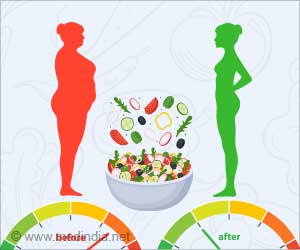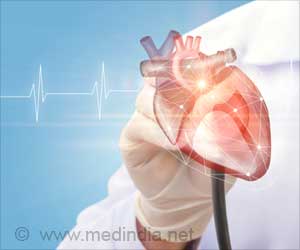Arterial stiffness is the new and better predictor for Type 2 diabetes compared to high blood pressure (BP) and standard risk factors.

‘Regular physical activity, eating a healthy and balanced diet, quitting smoking, reducing stress, maintaining a proper sleep schedule and a healthy body weight can help prevent the risk of Type 2 diabetes and heart disease.’





Advertisement
Prevalence of Type 2 Diabetes
According to the U.S. Centers for Disease Control and Prevention, more than 37 million people in the U.S. in 2019 had diabetes, of which, approximately 90-95% of them had Type 2 diabetes.The prevalence of the condition in the U.S. continues to rise due to unhealthy lifestyles and the aging population.
Type 2 diabetes can lead to heart disease, kidney disease, stroke and premature death.
“Identification of individuals at high risk of developing Type 2 diabetes is of utmost importance since early intervention can help prevent the onset and slow the progress of the condition,” said Anxin Wang, Ph.D., senior study author and a researcher at the China National Clinical Research Center for Neurological Diseases at Beijing Tiantan Hospital in Beijing, China.
Previous studies have found that hypertension, or high blood pressure, is a risk factor for Type 2 diabetes.
Arterial stiffness, a common finding in people with high blood pressure,
is also associated with insulin resistance and Type 2 diabetes.“Since people with either hypertension or arterial stiffness tend to have a higher risk of developing Type 2 diabetes, we investigated which of these factors may be more effective in predicting an individual’s future risk of Type 2 diabetes,” Wang said.
Advertisement
Link Between Hypertension and Diabetes
Researchers examined health data from 11,156 participants of the Kailuan study, an ongoing, prospective study of more than 100,000 adults aged 18 to 98 years in Tangshan, China.The study began in 2006 and tracks adults at 11 hospitals in the Kailuan community.
Resting blood pressure measurements and fasting blood samples were taken every two years, and measurements of artery wall stiffness were added in 2010.
Artery wall stiffness was calculated by using brachial-ankle pulse wave velocity, a standard technique that uses a blood pressure cuff placed on a participant’s arm and ankle to measure the rate at which pressure waves move down the blood vessels.
In this study, participants were defined as having hypertension if their resting blood pressure was 140 mm Hg/90 mm Hg or greater, which is in line with both the 2018 Chinese Guidelines for Prevention and Treatment of Hypertension and the International Society of Hypertension’s 2020 guidelines.
The American Heart Association’s 2017 guideline considers people with blood pressure of 130 mm Hg/80 mm Hg or higher to have hypertension.
The researchers defined patients as having Type 2 diabetes based on either measuring a fasting blood sugar level of ≥7.0 mmol/L, or they self-reported a physician diagnosis reported taking antidiabetic medications.By 2017, six years after the cohort began being tracked, approximately 7% of the study participants had developed Type 2 diabetes. The analysis compared the risk of Type 2 diabetes among people with: 1) ideal vascular function, defined as normal blood pressure and arteries that exhibited normal amounts of stiffness; 2) normal blood pressure with stiffer arteries; 3) high blood pressure and normal arteries; and 4) high blood pressure with stiffer arteries.
The analysis found that:
- In comparison to the group with ideal vascular function, study participants with elevated arterial stiffness combined with high blood pressure had the highest risk of developing Type 2 diabetes.
- Individuals with normal blood pressure and stiffer arteries also had an increased risk of Type 2 diabetes as compared to the group with ideal vascular function.
- Participants with high blood pressure and normal arterial stiffness had the lowest risk of Type 2 diabetes.
The analysis also found that
the combination of high blood pressure and stiffer arteries was more likely in men, and among people who were older,
had a higher BMI (body mass index, which is a measure of body weight in proportion to height) and higher heart rate and reported smoking cigarettes and drinking alcohol.People with increased arterial stiffness also had higher fasting blood glucose and cholesterol levels compared to participants who did not. Additionally, the researchers found that adjusting the analysis to consider BMI did not change the association between arterial stiffness and Type 2 diabetes.
Advertisement
Modifiable Risk Factors of Type 2 Diabetes
”These findings provide new insight into the prevention of Type 2 diabetes, indicating thatearly detection and treatment for high blood pressure and arterial stiffness may help reduce the risk of developing Type 2 diabetes
,” Wang added.Wang adds that more studies are needed to further investigate the underlying mechanisms involved in the associations for arterial stiffness, high blood pressure and Type 2 diabetes risk and to determine the optimal range of arterial thickness and blood pressure for preventing Type 2 diabetes.
According to the American Heart Association, there are several modifiable risk factors for Type 2 diabetes linked to healthy lifestyle choices, which contribute to achieving optimal heart health: physical activity, managing cholesterol and high blood pressure, proper diet, not smoking cigarettes, reducing stress, maintaining a proper sleep schedule and a healthy body weight.
“This finding that arterial stiffness increases the risk for developing Type 2 diabetes supports our existing understanding of cardiovascular disease and Type 2 diabetes,” said Eduardo Sanchez, M.D., M.P.H., FAHA, FAAFP, the American Heart Association’s chief medical officer for prevention, who is the clinical lead for Know Diabetes by Heart, a collaborative initiative between the American Heart Association and the American Diabetes Association addressing the link between diabetes and cardiovascular disease.
“We look forward to future investigations about the mechanisms between arterial stiffness and Type 2 diabetes risk.”
Co-authors are Xue Tian, Ph.D.; Yingting Zuo, Ph.D., Shuohua Chen, M.D.; Yijun Zhang, M.S.; Xiaoli Zhang, B.S.; Qin Xu, Ph.D.; and Shouling Wu, M.D. Authors’ disclosures are listed in the manuscript.
This study was supported by the National Key Research and Development Program of China and the Beijing Municipal Administration of Hospitals Incubating Program.
Source-Newswise













